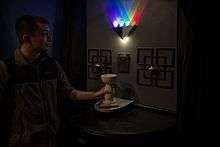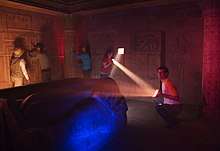Escape room
An escape room, also known as an escape game, is a game in which a team of players cooperatively discover clues, solve puzzles, and accomplish tasks in one or more rooms in order to progress and accomplish a specific goal in a limited amount of time.[1] The goal is often to escape from the site of the game.

Escape rooms became popular in North America, Europe and East Asia in the 2010s. Permanent escape rooms in fixed locations were first opened in Asia[2] and followed later in Hungary, Serbia, Australia, New Zealand, Russia and South America.[3]
Definition
Escape rooms or Escape boxes are inspired by "escape-the-room"–style video games. This is also the likely source of their name.[4] It is also referred to as Room Escape, Escape Game, Exit Game and Live Escape.[5]
In spite of the name, escaping a room may not be the main goal for the players, nor is the game necessarily confined to a single room.[6]
Game play overview
The participants in an escape room normally play as a cooperative team ranging anywhere between two and ten players.[4] Games are set in a variety of fictional locations, such as prison cells, dungeons, and space stations. The player's goals and challenges they encounter usually follow the theme of the room.
The game begins with a brief introduction to the rules of the game and how to win. This can be delivered in the form of video, audio, or a gamemaster.[1]
After this, the clock is started and players have 45 to 60 minutes to complete the game. During this time, players explore, find clues, and solve puzzles that allow them to progress further in the game. Challenges in an escape room lean more to mental than physical, and it is not necessary to be physically fit or dextrous.[6]
If a team gets stuck, there is a mechanism in place for the players to ask for hints. These hints can be delivered using paper, video, audio, or a gamemaster in the room.
If the players are unable to solve the game's puzzles within a time limit, the team is typically notified by the game's operator and escorted out of the room.
If players achieve the goal within the time limit, they win the game. Sometimes, teams with fast times are placed on a leaderboard.[6] Most escape rooms have clues and codes to unlock other areas.
Game design
Puzzle solving
Escape rooms contain a variety of puzzles and challenges that, when solved, unlock access to new areas in the game. Sometimes teams will have to multitask to unlock other areas.
| Puzzle types in an escape room | Survey Response |
|---|---|
| Searching for physical objects hidden in the room | 78% |
| Team Communication | 58% |
| Light | 54% |
| Counting | 53% |
| Noticing something "obvious" in the room | 49% |
| Symbol substitution with a Key (such as looking symbols up in a book) | 47% |
| Using something in an unusual way (Out-of‐the‐box thinking) | 47% |
| Searching for objects in images | 43% |
| Assembly of a Physical object (such as a jigsaw puzzle) | 40% |
| Algebra and other Mathematics | 39% |
| Pattern identification (such as visualizing a shape in a set of dots) | 38% |
| Riddles | 37% |
| Ciphers without a Key (such as letter substitution) | 35% |
| Hearing | 26% |
| Mirrors | 26% |
| Abstract logic (such as Sudoku) | 22% |
| Research using information sources | 20% |
| Strategic thinking (such as Chess) | 20% |
| Hand-‐eye Coordination (such as shooting a target) | 17% |
| Rope or chains (such as undoing complex knots) | 16% |
| Traditional Word Puzzles (such as crosswords or word search) | 14% |
| Mazes | 14% |
| Physical Agility (such as a laser maze) | 13% |
| Touch | 12% |
| Knowledge of facts not provided in the room | 11% |
| Shape manipulation (such as a matchstick puzzle) | 11% |
| Liquids | 9% |
| Physical engagement with actors | 4% |
| Smell | 3% |
| Taste | 1% |
An example of an escape room puzzle would be placing a code on a spinning fan so that it can only be read using a stroboscope in the dark. Therefore, players have to turn off the light, turn on the stroboscope, notice the spinning fan, read the code and apply it later in the game.[7]
Stories and themes
Escape rooms usually have a story line or theme (depending on the style of the game).[8] Common themes and story lines often found in escape rooms include:
- Airplane
- Bomb Defusing
- Carnival
- Detective/Police/Crime
- Dream
- Heist / Thieves
- Historical
- Horror
- Library
- Medical / Asylum
- Military
- Magic
- Music
- Office
- Pirate
- Prison
- Science
- Serial Killer
- Sherlock
- Space
- Spy
- Supernatural
- Tomb / ancient civilization
- Vampire
- Western
- Zombie
According to a 2019 survey polling escape room enthusiasts, the most popular themes reported were Detective/Police/Crime, Sherlock, and Spy. The least popular were Zombie, Dreams, and Magic.[9]
History
Different attractions contained elements similar to modern escape rooms and could thus be seen as precursors to the idea, including haunted houses, scavenger hunts, entertainment center 5 Wits or interactive theater (such as Sleep No More, inaugurated in 2003). An additional inspiration for escape rooms came from the "escape the room" genre of video games. Escape the room games, which initially began as Flash games for web browsers and then moving onto mobile apps, challenged the player to locate clues and objects while within a single room.[10]

The earliest concept to resemble a modern escape room was True Dungeon, which premiered at GenCon Indy in Indianapolis, USA, in July 2003.[11][12] Created by Jeff Martin (True Adventures LLC), True Dungeon had many of the same elements that people associate with escape rooms today; a live-action team-based game where players explored a physical space and cooperatively solved mental and physical puzzles to accomplish a goal in a limited amount of time. True Dungeon "focuses on problem solving, teamwork, and tactics while providing exciting sets and interactive props".[13]
Four years later, Real Escape Game (REG) in Japan was developed by 35-year-old Takao Kato,[14] of the Kyoto publishing company, SCRAP Co., in 2007. It is based in Kyoto, Japan and produces a free magazine by the same name. Beyond Japan, Captivate Escape Rooms appeared in Australia and Singapore from 2011,[15] the market growing to over 60 games by 2015.[1] Kazuya Iwata, a friend of Kato, brought Real Escape Game to San Francisco in 2012.[16] The following year, Seattle-based Puzzle Break founded by Nate Martin became the first American-based escape room company.[17][18][19][20][21][22][23][24] Japanese games were primarily composed of logical puzzles, such as mathematical sequences or colour-coding, just like the video games that inspired them.
Parapark, a Hungarian franchise that later operated in 20 locations in Europe and Australia, was founded in 2011 in Budapest.[25] The founder, Attila Gyurkovics, claims he had no information about the Japanese escape games and based the game on Mihály Csíkszentmihályi's flow theory and his job experience as personality trainer.[26] As opposed to the Japanese precursors, in the games of Parapark players mainly had to find hidden keys or reach seemingly unattainable ones in order to advance.
In 2012 a Swiss physics professor created a scientific escape game for his students. The game was later offered to the public under the name of AdventureRooms and distributed as a franchise in twenty countries. The Adventure Rooms introduced scientific puzzles (e.g. hidden infrared or polarized codes) to the genre.[27][28]
As of November 2019, there were estimated to be over 50,000 escape rooms worldwide.[29] These can be particularly lucrative for the operators, as the upfront investment has been as low as US$7,000, while a party of 4-8 customers pay around US$25–30 per person for one hour[30] to play, potentially generating annual revenue upwards of several hundred thousand dollars.[31] As the industry has grown, start up costs have increased dramatically and so have the competition. Customers now expect higher production values and often games can cost over $50,000 to create. The UK has seen the market grow by over the past 5 years by 93%, 148%, 409% and 43%[32]
The format of a room or area containing puzzles or challenges has featured in multiple TV game shows over the years, including Now Get Out of That,[33] The Adventure Game,[34] The Crystal Maze,[34] Fort Boyard and Knightmare.[35] A similar experience can be found in interactive fiction software, and escape the room video games.
Reception

The South China Morning Post described escape rooms as a hit among "highly stressed students and overworked young professionals."[36] Sometimes the excitement becomes a bit much, though, and players get so invested that they tear down equipment or decorations inside their "fake" prisons.[37]
The use of Hong Kong room "escapes" as distractions from the living conditions of the real city of Hong Kong has been reviewed by local journalists.[38][39]
Evolution
Early games consisted mainly of puzzles that were solved with paper and pencil. As Escape Rooms progressed physical locks were introduced that could be opened by finding combinations, hidden keys and codes using objects found in the rooms. These ideas have evolved to include automation technology, immersive decoration[40] and more elaborate storylines to enhance the visitor experience, make puzzles more interactive, and to create an experience that is more theatrical and atmospheric.
The development of the new device as head-mounted display allows complement or even replace modern approaches to entertainment in the field of Escape Rooms. Multiplayer VR game ability can turn old school designed Escape Rooms into a new wave of Escape Games at virtual reality with big themes variety of locations and styles. Developers of VR Escape Rooms include Ubisoft, Exit, VR Cave, ARVI VR, and Escape VR.
Safety
The first known fatal accident to occur in an escape room was the death of five 15-year-old girls in a fire in Koszalin, Poland, on 4 January 2019. The fire was caused by a leaky gas container inside a heater and resulted in the death of the five victims from carbon monoxide poisoning and injuries to one employee, who was treated for burns. According to the state firefighting service, the chief failure that led to the deaths was the lack of an effective evacuation route. Shortly after the accident, authorities ordered safety checks in escape rooms across Poland and 13 more such establishments were shut down for safety flaws as a result.[41][42]
References
- "Peeking Behind the Locked Door: A Survey of Escape Room Facilities" (PDF). White Paper. Retrieved 2015-05-24.
- "The unbelievably lucrative business of escape rooms". MarketWatch. Retrieved 20 July 2015.
- Raspopina, Sasha (2015-07-23). "Great escapes: the strange rise of live-action quest games in Russia". The Guardian. ISSN 0261-3077. Retrieved 2017-01-16.
- Penttilä, Katriina (14 August 2018). History of Escape Games : examined through real-life-and digital precursors and the production of Spygame (Thesis). Retrieved 5 January 2019 – via www.utupub.fi.
- "A history of room escapes – terminology and the different names that a room escape is called". Intervirals Blog. 2015-02-18. Retrieved 2019-06-21.
- Wiemker, Markus; Elumir, Errol; Clare, Adam (November 2015). "Escape Room Games: "Can you transform an unpleasant situation into a pleasant one?"" (PDF). White Paper.
- "101 Best Escape Room Puzzle Ideas". Nowescape Blog. 2016-03-18. Retrieved 2018-03-11.
- "Escape game style - UK Escape Game Wiki".
- "2019 Escape Room Enthusiast Survey". thecodex.ca. 2019-12-12.
- Suellentop, Chris (June 4, 2014). "In Escape Rooms, Video Games Meet Real Life". The New York Times. Retrieved December 20, 2019.
- Sjoberg, Lore (2008-08-13). "True Dungeon Lures Would-Be Dragon Slayers". Wired. ISSN 1059-1028. Retrieved 2019-08-22.
- "True Dungeon: True Dungeon Timeline: 2003 Info (1/7)". new.truedungeon.com. Retrieved 2019-08-22.
- "True Dungeon - Real Dungeon. Real Props. Real Cool". web.archive.org. 2007-06-30. Retrieved 2019-08-22.
- Corkill, Edan (2009-12-20). "Real Escape Game brings its creator's wonderment to life". The Japan Times Online. Japan Times. Retrieved 2013-03-31.
- Marinho, Natalie (2012-01-31). "The Real Escape Game in Singapore". recognitionpattern. Archived from the original on 2012-07-24. Retrieved 2013-03-31.
- Cheng, Evelyn (21 June 2014). "Real-life 'escape rooms' are new US gaming trend". CNBC. Retrieved 12 July 2016.
- "IQ Escape center opens new game, partners with school". Pittsburgh Post-Gazette. Retrieved 2018-10-30.
- "What Running An Escape Room Taught Me About People". Cracked.com. 2016-10-17. Retrieved 2018-10-30.
- Group, Sinclair Broadcast. "What in the world is an Escape Room, and how do you survive it??". Seattle Refined. Retrieved 2018-10-30.
- "Geek of the Week: There's no escaping it — Puzzle Break's Nate Martin created his dream startup". GeekWire. 2018-06-22. Retrieved 2018-10-30.
- "Escape Room Blogs, Conferences, Groups, and Podcasts". Xola University. 2018-05-21. Retrieved 2018-10-30.
- "Can You Escape This Room in 60 Minutes?". Long Island News from the Long Island Press. 2018-03-30. Retrieved 2018-10-30.
- "Puzzle Break: Country's first escape room located in Seattle". KING. Retrieved 2018-10-30.
- Galbraith, Susan. "What in the world is an Escape Room, and how do you survive it??". KOMO. Retrieved 2017-04-19.
- Bence, Gyulai (2011-09-09). "ParaPark: tökéletes élmény egy romkocsma pincéjében". Retrieved 2016-07-17.
- Kummer, Krisztián (March 2013). "Room escape games the latest craze in Budapest". Budapest Business Journal.
- Hess, Stéphane (September 10, 2013). "Physik: Kriminelle Energie erwünscht" (PDF). "BILDUNG SCHWEIZ" (Education Switzerland). pp. 24–25. Retrieved April 21, 2018.
- Tremaine, Fergus (March 21, 2018). "How an enquiry landed me in the centre of a powerhouse brand". Linkedin. Retrieved April 21, 2018.
- "International Escape Room Markets analysis| The Logic Escapes Me". thelogicescapesme.com. Retrieved 2020-02-21.
- "For $28, this Alpharetta business will lock you inside a room". myajc. Retrieved 2017-01-16.
- French, Sally; Shaw, Jessica Marmor (July 20, 2015). "The unbelievably lucrative business of escape rooms". MarketWatch. Retrieved June 19, 2016.
- Escapes, Logic; Escapes, Logicr (August 20, 2018). "Analysis of the UK market – 2018". Logicescapesme. Retrieved December 19, 2018.
- "Now Get Out of That". Labyrinth Games. Retrieved 2018-01-04.
- "Prigionieri in una scatola?". Io Gioco (in Italian) (supplement to The Games Machine n. 346). 2017. p. 20.
- "Origins - UK Escape Game Wiki". www.escaperoomuk.com.
- "Real-life escape games offer respite from daily stresses". South China Morning Post. Retrieved 2016-10-14.
- "Rooms with a different kind of view|People|chinadaily.com.cn". usa.chinadaily.com.cn. Retrieved 2016-10-14.
- "Real-life escape games offer respite from daily stresses|". South China Morning Post. 2013-02-13. Retrieved 2013-04-10.
- "Hong Kong Thrill Seekers think their way to freedom|". CBC News. 2013-02-22. Retrieved 2013-02-22.
- "Immersion - UK Escape Game Wiki". www.escaperoomuk.com. Retrieved 2019-10-10.
- "Escape room fire kills five teenagers in Poland". BBC News. 2019-01-04.
- "Man charged after 5 girls killed in escape room fire in Poland". Global News. 2019-01-06.
External links
| Wikimedia Commons has media related to Escape rooms. |